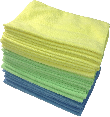Whether you have a small aquarium containing five fish, or a larger one housing twenty-five species and a complicated filtration system, you need to clean your aquarium regularly. Waste and uneaten fish food decompose into ammonia, and then a bacterium combines with the ammonia to form nontoxic nitrates, providing a balanced environment for fish to live. If you do not change your aquarium water regularly, the bacteria will not be able to keep up with the waste, creating dangerous levels of ammonia.
While there are widely differing opinions as to how to clean an aquarium, the general consensus is the more you clean it, the healthier your fish will be. If your aquarium is less than five months old, you should replace half of its water every two weeks. Older aquariums only need one-third of their water changed once a month. Never remove more than half of the water from your aquarium at any one time, and follow these tips when cleaning your aquarium:
Keep in mind that your aquarium holds helpful bacteria. If you clean your tank too often, you will create an unhealthy environment for your fish. Frequent filter changes also rid the environment of healthy bacteria.

The Power of Microfiber! Zwipes Microfiber Cleaning Cloths will become your favorite tool for every cleaning task. This 36-cloth package is perfect for hundreds of uses in the garage, kitchen, bathroom, laundry, and all around the house. Each cloth is tough, streak-free, lint-free, reusable, and washable. Check out Microfiber Cleaning Cloths today!
Water based paints will absorb water and become rubbery making it easy to peel the paint right off of the glass. Razors ...
Discover MoreGetting a stubbornly stuck decanter open and cleaned out can be quite the challenge. This tip provides some guidance on ...
Discover MoreAntique porcelain plates are a beautiful investment that no one really wants to see go to waste. Over time, these plates ...
Discover MoreFREE SERVICE: Get tips like this every week in Cleaning Tips from Tips.Net. Enter your address and click "Subscribe."
There are currently no comments for this tip. (Be the first to leave your comment—just use the simple form above!)
FREE SERVICE: Get tips like this every week in Cleaning Tips from Tips.Net. Enter your address and click "Subscribe."
Copyright © 2025 Sharon Parq Associates, Inc.
Comments